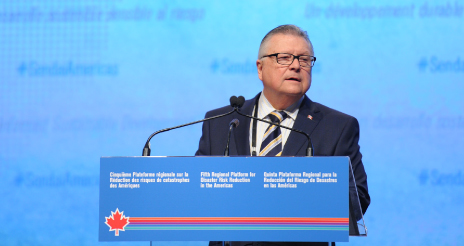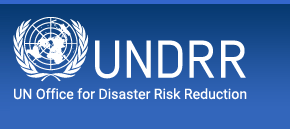- Our Mandate
- Mission and Objectives
- UNDRR in the UN
- Work Programme & Annual Reports
- Results Based System
- Work Partnerships
- Headquarters - Geneva
- SG-UN representatives for DRR
- Regional Office – The Americas and the Caribbean
- Head of the Regional Office – The Americas and the Caribbean
- What is Disaster Risk Reduction?
- What is the International Strategy?
- History of UNDRR
Americas region crafts disaster risk reduction plan

Mr. Ralph Goodale, Canada's Minister of Public Safety and Emergency Preparedness, said the 5th Regional Platform for Disaster Risk Reduction in the Americas is set to endorse a "robust" plan for curbing the risks posed by natural and human-induced hazards (Photo: UNDRR)
By Jonathan Fowler
MONTREAL, Canada, 7 March 2017 – The vast Americas region today started a high-level conference on a wide-ranging plan that will seek to reduce the risks posed by natural and human-induced hazards.
The three-day 5th Regional Platform for Disaster Risk Reduction in the Americas has drawn a thousand delegates from over 50 countries and territories to Montreal.
In his opening speech, said Mr. Robert Glasser, Special Representative of the UN Secretary-General for Disaster Risk Reduction, said he expected the conference to "help bring us closer to a disaster-resilient future where the focus is on reducing existing levels of risk and avoiding the creation of new risk. "
Stretching from the Arctic to Tierra del Fuego, the Americas faces an array of hazards, the impacts of which are compounded by factors such as poverty, breakneck urbanization, and climate change.
"Like many of our hemispheric partners here today, we experience a full range of natural and man-made hazards – most recently evident in the beast of a wildfire in Fort McMurray, Alberta," said Mr. Ralph Goodale, Canada's Minister of Public Safety and Emergency Preparedness, as he opened the conference.
"Some countries with us today are recovering from the very adversities that we are here to discuss. Our friends in Chile have, very recently, experienced heavy rains and landslides in the Andes mountains – only a short while after seeing a chain of wildfires that unleashed devastation on a scale never before seen. California, too, had a brutal summer of wildfires in 2016 that left hundreds of homes, and many thousands of acres, destroyed. And we all remember that last year's Hurricane Matthew brought destruction to both the Caribbean and the Southeast United States," he said.
A key goal of the conference is to endorse what Minister Goodale said would be a "robust" three-year plan aligning the America's efforts with the Sendai Framework for Disaster Risk Reduction, a 15-year global agreement adopted in 2015.
The plan will also feed into the 2017 Global Platform on Disaster Risk Reduction, in Mexico in May. Africa, Asia and Europe have already laid out similar plans.
The Sendai Framework's seven targets include substantially reducing lives lost, numbers of people affected, and economic losses. It also seeks to curb damage to critical infrastructure and disruption to basic services such as health and educational facilities. Other key aims are to increase the number of countries with national and local risk reduction strategies by 2020, bolster the capacity of developing countries, and vastly improve coverage by early warning systems.
The Sendai Framework links closely with the Paris Agreement on climate change and the Sustainable Development Goals, likewise adopted in 2015.
"I recognise that reducing greenhouse gas emissions is arguably the single greatest long-term contribution that governments, local governments and the private sector can make to reduce the risk of disasters," said Mr. Glasser, who applauded Canada's emissions-cutting plan.
"Otherwise we are going to see a further escalation in weather and climate-related disaster events, severe storms, droughts and floods fuelled by rising temperatures and rising sea-levels, with cascading impacts on food security and even conflict. Already we know that these hydro-meteorological events have doubled over the last twenty years and account for 90% of all disasters caused by natural hazards."
"Climate change adaptation and mitigation are inextricably linked to disaster risk reduction," he said.
Underscoring the challenges, Mr. Glasser spotlighted last October's Hurricane Matthew, noting that there were 546 officially-confirmed deaths in Haiti, a country still recovering from its devastating 2010 earthquake.
That shows the importance of alert systems, he said, an issue that will be discussed at May's Multi-Hazard Early Warning Conference, running alongside the Global Platform.
Mr. Glasser also underlined the economic impact of disasters, now put at US$500 billion a year.
Hurricane Matthew alone caused damage estimated at US$15 billion when it scythed across Haiti, Cuba, the Dominican Republic, the Bahamas, the United States and the Canadian Maritimes.
It was a stark reminder that disasters can swallow scarce resources that could otherwise have been invested in health and education, particularly in low- and middle-economic countries that can least afford the losses, said Mr. Glasser. Hurricane Matthew cost Haiti around one-third of its Gross Domestic Product, in a country where over half of the population lives below the poverty line.
Mr. Glasser lauded efforts by Latin America to reduce the impact of the 2014-2016 El Nino event, which caused droughts and floods. While not as severe as the 1980s and 1990s versions, its results were dented by preparedness plans.
"It is efforts such as these which we must now build on," he said. "This will lay the foundations for a decade of concerted action on reducing disaster losses."
Related links
5th Regional Platform for Disaster Risk Reduction in the Americas wesbite
Follow the UNDRR news online:
 Now we have twitter account @UNDRR Américas y el Caribe
Now we have twitter account @UNDRR Américas y el Caribe
JOIN US!
Tweets por el @UNDRR Américas y el Caribe
